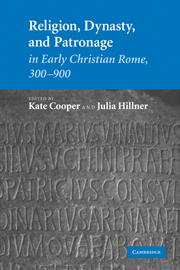Book contents
- Frontmatter
- Contents
- Acknowledgements
- List of contributors
- Abbreviations
- Introduction
- PART I ICONS OF AUTHORITY: POPE AND EMPEROR
- PART II LAY, CLERICAL, AND ASCETIC CONTEXTS FOR THE ROMAN GESTA MARTYRUM
- PART III RELIGION, DYNASTY, AND PATRONAGE
- 6 Poverty, obligation, and inheritance: Roman heiresses and the varieties of senatorial Christianity in fifth-century Rome
- 7 Demetrias ancilla dei: Anicia Demetrias and the problem of the missing patron
- 8 Families, patronage, and the titular churches of Rome, c. 300–c. 600
- 9 To be the neighbour of St Stephen: patronage, martyr cult, and Roman monasteries, c. 600–c. 900
- Bibliography
- Index
9 - To be the neighbour of St Stephen: patronage, martyr cult, and Roman monasteries, c. 600–c. 900
Published online by Cambridge University Press: 02 October 2009
- Frontmatter
- Contents
- Acknowledgements
- List of contributors
- Abbreviations
- Introduction
- PART I ICONS OF AUTHORITY: POPE AND EMPEROR
- PART II LAY, CLERICAL, AND ASCETIC CONTEXTS FOR THE ROMAN GESTA MARTYRUM
- PART III RELIGION, DYNASTY, AND PATRONAGE
- 6 Poverty, obligation, and inheritance: Roman heiresses and the varieties of senatorial Christianity in fifth-century Rome
- 7 Demetrias ancilla dei: Anicia Demetrias and the problem of the missing patron
- 8 Families, patronage, and the titular churches of Rome, c. 300–c. 600
- 9 To be the neighbour of St Stephen: patronage, martyr cult, and Roman monasteries, c. 600–c. 900
- Bibliography
- Index
Summary
Roman monasticism in the early middle ages presents a paradox. ‘No other city in Christendom, save perhaps Constantinople, witnessed the flowering of monastic life as did Rome.’ The sources reveal a count of nearly a hundred monasteries founded in the City of Rome between the fifth and the tenth centuries. Forty-nine of these appear in the roll-call of Roman ecclesiastical institutions included in the Liber Pontificalis entry for Leo III in 806/7 – suggesting that eighth-century Rome, no less than Skellig Michael off the south-west coast of Ireland or S. Vincenzo al Volturno in the Abruzzi, played a part in the heroic era of monastic foundation in early medieval Europe. And yet, having enumerated the Roman monasteries of this period, there seems to be very little else we can say about them. Thus Guy Ferrari's (still indispensable) Early Roman Monasteries: Notes towards a History of Monastic Observance in Rome takes its title advisedly, as a warning to avoid disappointment on the part of those expecting a sustained analysis of the city's monastic life. The Notes are set out as a series of institutional biographies, in alphabetical order – but what Ferrari in fact shows is the impossibility of rendering the papal biographies of the Liber Pontificalis, and the evidence from other sundry documentary or epigraphic sources, into a coherent and satisfying fulfilment of his own scheme. In the fifty years since the publication of Early Roman Monasteries, no one has attempted to write up Ferrari's Notes.
- Type
- Chapter
- Information
- Publisher: Cambridge University PressPrint publication year: 2007
- 5
- Cited by



